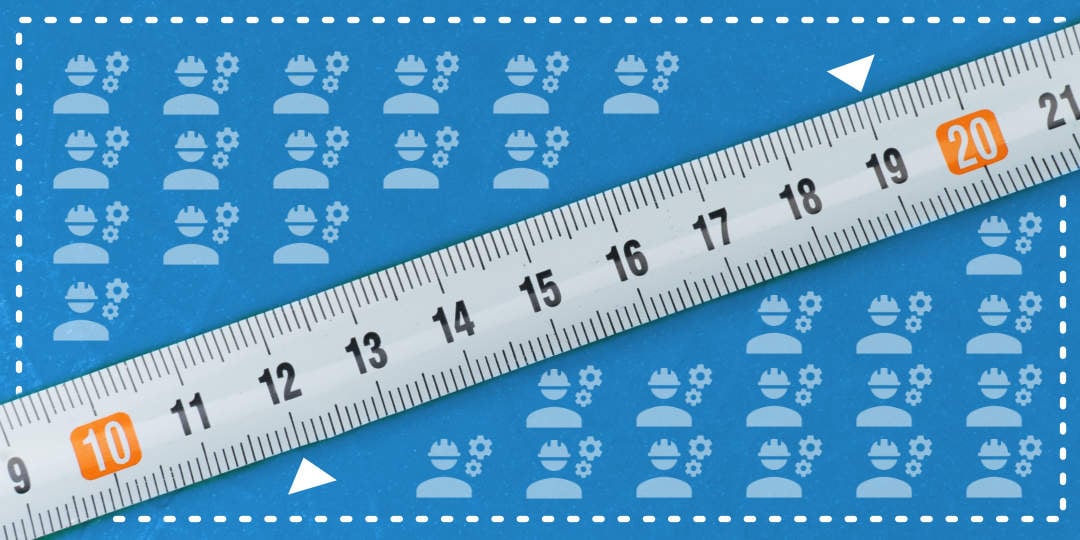What Size Should My Labor Pool Be?
So you’ve started using on-demand labor, but you’re not so sure about how many people you should be adding to your labor pool. Maybe someone told you a number that was so high it shocked you, or maybe you’ve been flying solo and don’t know what you should be aiming for.
At Veryable, we’ve helped hundreds of companies gain flexible capacity through their labor pools. We’ve tested many different ways of coaching businesses through this process to find what works, and now we’re sharing what we’ve learned so that you can replicate the most successful labor pool builders.
In this article, you’ll learn how to calculate what size your labor pool should be and how to keep track of your progress.
How to find your ideal labor pool size
To find out how big your labor pool should be, the first step is to understand your demand profile. The value of the labor pool model is the ability to match your labor to your demand. The only way to do that is to first start mapping out your demand. We know demand is extremely volatile and unpredictable, so the good news is that we just need to understand two main data points to calculate how big your labor pool should be:
- Minimum Headcount Needed
- Maximum Headcount Needed
With these two inputs, we’ll be able to calculate the ideal size of your labor pool using the equation below:
(Max headcount needed - Min headcount needed) * 3 = Labor Pool Target
As you can see in the equation, we’ve added a multiple of 3 which is what we call the “Labor Pool Multiple.” We’ll discuss this multiple later, but first, let’s go through examples of putting these metrics into practice.
Examples of labor pools for different demand profiles
Labor pool example for demand volatility
Let's go through an example of a demand profile we see in many businesses. Imagine that a business has day-to-day demand that is volatile, swinging above and below the average.
With a full-time workforce, the business struggles to ramp its headcount up and down quickly with the demand. Below is a graph of what it looks like when headcount can't keep up with demand in one direction or the other.

As you can see in the graph above, the business’s full-time headcount is 12. When demand dips below the workers needed of 12 operators, it’s simply overstaffed. When demand is above, the business uses overtime to address the extra demand.
You can also see that on the days with the lowest demand, the business really only needs 10 people. On the highest demand days, the business actually needs 14 people. Now we can use the labor pool equation introduced earlier in this article:
(Max headcount needed - Min headcount needed) * 3 = Labor Pool Target
So for this example, the equation is (14 - 10) * 3 = 12. The result of 12 as the business’s labor pool target means that it should bring in different Operators over time to evaluate them, adding workers the business likes to its labor pool until it reaches a size of 12 workers.
Then, to optimize efficiency in the business’s operations, we’d suggest the business should be at 10 full-time employees and post Ops to its labor pool of 12 operators whenever needed. When the business selects only the workers it needs based on demand, its headcount will look like the graph below.

As you can see, by adding a labor pool, the business has matched its labor with its demand perfectly. No more overtime, no more being overstaffed.
Labor pool example for project-based demand profiles
Let’s try another example to explain a labor pool would work for a different demand profile. Our next business sees demand stay pretty consistent, but spikes up quickly when new projects come along. When this happens, the business tries to use overtime as much as it can. This is costing the business money, and it also misses out on possible revenue because it can’t handle all the requested orders.
The graph below shows what the business’s demand profile looks like.

From the graph we can get the two data points we need to calculate the ideal labor pool:
- Minimum Headcount Needed: 10
- Maximum Headcount Needed: 20
Now we can put these inputs through the labor pool equation:
(Max headcount needed - Min headcount needed) * 3 = Labor Pool Target
In this case, the math works out to (20 - 10) * 3 = 30.
Below is how the business would activate its labor pool once the demand spikes hit:

Now, the company is flexing its available workers to meet the demand in real-time. No more overtime, no more missed revenue. Instead, the business can take on more orders and win more contracts from customers knowing it can ramp up with any demand surges that come its way.
Why your labor pool should be bigger than your immediate need
Like previously mentioned, part of the labor pool equation is the labor pool multiple. We advise businesses to triple the workers they typically need to meet demand variation. There are multiple reasons why we advise that you do this.
Your favorite Operators aren't always available
Having a bigger labor pool ensures enough operators are available to work the days you need them. Not every operator is going to be able to work at your company every time you need them. This is what makes on-demand labor different from other solutions: workers choose when and where they work.
Demand increases can be met with a bigger labor pool
Demand is unpredictable. Even though it’s good practice to map out your demand, your maximum demand can always increase. When demand goes beyond even your highest of projections, your labor pool won’t be holding you back.
Your labor pool can fill gaps created by turnover
A bigger labor pool can mitigate the effects of turnover. In the previous examples, we were assuming that your full-time headcount is always constant. We know that’s not how the real world works. When turnover spikes, you can utilize the extra capacity in your labor pool to ensure you have enough workers until you can backfill your turnover.
Strategies for building a labor pool successfully
If this sounds great to you, but you aren’t sure how to get your labor pool where it needs to be, you can read our blogs on how to build a labor pool and how to fix your labor pool problems.
There is also a tool in the Veryable business portal that will help you keep track of your labor pool progress. It shows you what your target is and how you are progressing toward the goal agreed upon in your ramp plan. If you don’t feel that your labor pool target is accurate, please discuss it with your point of contact at Veryable.
Previous Posts
Why Your Operation Isn’t Too Complex or Specialized for On-Demand Labor
The Future of Manufacturing and Logistics
Create a free business profile today to explore our platform.






